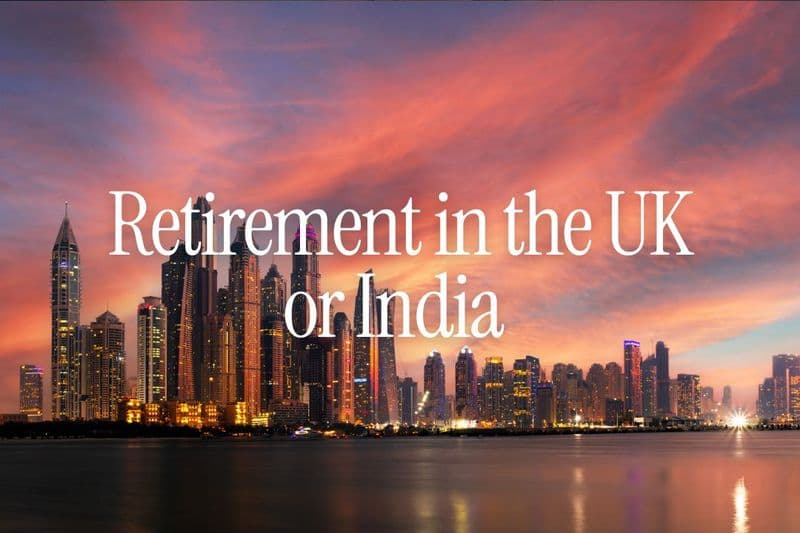
You're in your 40's, living in Reading for the past 15 years, earning well, paying into your UK pension. Your parents are aging in Delhi. Your kids were born here but speak Hindi. Your heart pulls toward India, but your bank account says UK.
This is the retirement riddle every UK NRI faces.
At Belong, we've spent years helping NRIs navigate this exact crossroads. We've seen software engineers retire to Goa with £300,000 pensions. We've watched doctors stay in Birmingham and regret missing their parents' last years. We've helped finance professionals split their time and get the best of both worlds.
This isn't just about money - though we'll talk numbers. It's about healthcare at 75, currency risk at 80, and what "home" means when you're 60. Our community of 10,000+ NRIs has lived through these decisions. This guide brings together their experience, our financial expertise, and real data to help you choose wisely.
Let's build your decision model.
Why This Decision Matters More Than You Think
Most UK NRIs approach retirement planning like a spreadsheet exercise. Cost of living in India: ₹80,000/month. UK pension: £1,500/month. Done.
But here's what they miss:
Your UK pension increases with inflation if you stay in the UK. If you retire to India, it's frozen at the amount you first claim - no annual increases. Over 20 years, that's a massive difference.
NHS access ends when you become a non-resident. Indian healthcare costs are 60-80% cheaper than UK/US, but you need private insurance. No employer is covering you anymore.
Your residential status under Indian tax law determines whether your global income is taxed. Get this wrong, and you could pay tax on your UK pension in both countries.
Currency fluctuation risk: Your £200,000 pension pot converts to ₹2 crore today. If GBP weakens by 15% (which happened 2016-2020), that becomes ₹1.7 crore. You just lost ₹30 lakhs.
These aren't small details. They're life-changing financial realities.
The Financial Reality: UK vs India Cost Comparison
Let's start with the numbers. According to Numbeo data, India's cost of living is 71-75% cheaper than the UK.
But that's misleading. Here's the real breakdown:
Monthly Living Expenses (Comfortable Lifestyle)
UK (Tier-2 City like Manchester)
- Rent (1-bed flat): £800-1,000
- Groceries: £250
- Utilities: £150
- Transport: £100
- Eating out/leisure: £200
- Healthcare (NHS): £0
- Total: £1,500-1,700/month (₹1.6-1.8 lakh)
India (Tier-1 City like Bangalore)
- Rent (2BHK apartment): ₹30,000-40,000
- Groceries: ₹12,000
- Utilities: ₹5,000
- Transport (driver + petrol): ₹15,000
- Eating out/leisure: ₹20,000
- Healthcare insurance: ₹8,000
- Total: ₹90,000-1,00,000/month
India (Tier-2 City like Coimbatore)
- Rent (3BHK): ₹15,000-20,000
- Groceries: ₹10,000
- Utilities: ₹3,000
- Transport: ₹10,000
- Eating out/leisure: ₹12,000
- Healthcare insurance: ₹8,000
- Total: ₹58,000-63,000/month
Surface-level, India looks way cheaper. But dig deeper.
👉 Tip: Use the Residential Status Calculator before making any retirement decisions. Your tax liability in India depends entirely on your residential status.
Also Read - How Much Money Does an NRI in the UAE Need to Retire Comfortably in India?
Healthcare: The Biggest Variable Nobody Plans For
Here's the truth about healthcare that most UK NRIs discover too late:
In the UK
Pros:
- NHS is free at point of use (if you remain a UK resident)
- Prescriptions: £9.90 per item (free if over 60)
- No health insurance needed
- Excellent infrastructure for chronic conditions
- No waiting for life-saving treatment
Cons:
- Long waiting lists for non-urgent surgery (6-18 months)
- Limited choice of specialists
- You lose NHS access if you become a non-resident
In India
Pros:
- Healthcare costs 60-80% less than UK/US
- Heart bypass: $5,000-8,000 (vs $70,000-150,000 in US)
- Knee replacement: $4,000-6,000 (vs $30,000-50,000 in US)
- Immediate access to specialists, no waiting
- World-class hospitals in metros (Apollo, Fortis, Max)
Cons:
- No free public healthcare for quality treatment
- Health insurance mandatory (₹1-2.5 lakh/year for couples over 60)
- Pre-existing conditions: 2-4 year waiting periods
- Healthcare inflation: 10-12% annually
According to Business Standard, there's been a 150% growth in NRIs buying health insurance in India (FY 2024-25 vs 2023-24). Why? Because they're planning to retire there.
But here's the critical mistake: buying insurance after you decide to move back.
Most health insurance policies in India have 2-4 year waiting periods for pre-existing conditions. If you're 55 and have hypertension or diabetes (very common), you need to buy Indian health insurance NOW, not when you're 60 and ready to move.
By the time you retire, the waiting period is over, and you're fully covered from day one.
👉 Tip: Buy health insurance in India 3-4 years before you plan to retire there. Choose policies with global coverage so you're protected even while still in the UK.
Also Read - How Inflation in India Impacts Your Retirement Savings
Your UK Pension: Can You Take It to India?
This is where it gets interesting.
UK State Pension
You CAN receive your UK state pension in India. As of 2025/26, the full new State Pension is £230.25/week (about £11,973/year).
The catch: Your state pension is FROZEN at the amount you first claim. No annual increases. Ever.
If you stay in the UK, your pension increases with inflation each year. Over 20 years, this difference is massive:
- Year 1: £11,973
- Year 10 (UK): ~£15,000 (with average 2.3% inflation)
- Year 10 (India): £11,973 (frozen)
- Difference after 10 years: ~£30,270
(Source)
Workplace Pensions
You can transfer your UK workplace pension to India through a QROPS (Qualifying Recognised Overseas Pension Scheme).
Benefits:
- Avoid UK Lump Sum and Death Benefit Allowance (LSDBA) charge (if over £1,073,100 (source)
- Manage currency risk by converting to INR
- More investment options
- No forced annuity purchase
Costs:
- 25% overseas transfer charge (if you've left UK \<5 years ago or pension \> £1,073,100)
- Transfer process: 2-6 months
- Complex tax implications
According to Wise, HMRC publishes a list of approved QROPS in India twice a month. There are multiple schemes to choose from, but each has different investment options and fee structures.
Private Pensions
Depends on your pension provider. Most allow overseas payments, but:
- Currency conversion fees apply
- Bank charges for international transfers
- No inflation protection
Tax Implications: The DTAA Lifeline
The India-UK Double Taxation Avoidance Agreement (DTAA) ensures you don't pay tax twice on the same income.
Here's how it works for retirees:
If You Retire in the UK
- Your UK pension is taxed in the UK (20-40% depending on income)
- Your Indian rental income, FD interest, dividends are taxed in India (but you can claim tax credits in the UK)
- No Indian tax liability if you remain a UK tax resident
If You Retire in India
- Your UK state pension: Taxed in the UK, but you can claim credit in India under DTAA
- Your workplace pension: Usually taxed in India (10-30% slab rate)
- Your NRE FD interest: Tax-free in India
- Your NRO FD interest: 30% TDS (reduced to 15% under DTAA if you have a Tax Residency Certificate)
According to ClearTax, UK residents can claim reduced TDS rates:
- Interest income from India: 15% (instead of 30%)
- Dividend income: 15% (instead of 20%)
Critical point: You need a Tax Residency Certificate (TRC) from HMRC and Form 10F filed with the Indian Income Tax Department to claim DTAA benefits.
👉 Tip: Consult a cross-border tax advisor before moving. One wrong step in changing your tax residency can cost you lakhs in unnecessary taxes.
The Currency Risk Nobody Talks About
Your £200,000 pension pot seems solid. But what happens when GBP-INR moves against you?
Historical GBP-INR Movement:
- 2013 avg: £1 = ₹91.7
- 2020 avg: £1 = ₹95.1
- 2024 avg: £1 = ₹107
- Nov 2025: ~£1 = ₹116
That's a gradual rupee strengthening, but not huge-until crises hit and it swings 10-15% in a year.
If the rupee strengthens to ₹95 again, your £2,000 monthly pension becomes ₹1.9 lakh instead of ₹2.32 lakh (at current rates). That's ₹42,000 less per month.
Over 20 years of retirement, currency fluctuation is your biggest risk.
How to Manage Currency Risk
Option 1: FCNR Fixed Deposits Keep your UK pension in GBP. FCNR deposits let you maintain foreign currency in India. Interest rates: 3-4% on GBP deposits.
Option 2: GIFT City USD Fixed Deposits Convert to USD (more stable than GBP-INR). GIFT City FDs offer 4.5-6% on USD deposits, tax-free, fully repatriable.
Option 3: Split Strategy Keep 50% in GBP/USD deposits, 50% in INR investments. Diversification reduces risk.
Use the Rupee vs Dollar Tracker to monitor exchange rate trends and time your conversions wisely.
Quality of Life: Beyond the Spreadsheet
This is where emotions meet reality.
UK Retirement
Pros:
- Political stability
- Social security systems
- Excellent public infrastructure
- Safety and rule of law
- Cultural diversity
- Easy travel to Europe
- Active senior citizen community
Cons:
- Expensive lifestyle
- Cold, depressing weather 7-8 months a year
- Limited family connection (if parents are in India)
- Aging alone if kids move elsewhere
- High cost of assisted living (£3,000-5,000/month)
India Retirement
Pros:
- Proximity to aging parents/extended family
- Domestic help is affordable (cook, driver, cleaning staff)
- Warm weather year-round
- Cultural familiarity
- Better food quality (fresh, not processed)
- More social interaction
- Festivals, community events
Cons:
- Pollution in major cities
- Infrastructure challenges (power cuts, water issues in some areas)
- Traffic and noise
- Bureaucracy for any government work
- Healthcare quality varies greatly by city
- Less structured systems for assisted living
According to Belong's survey of returning NRIs, the top cities for retirement are:
- Coimbatore - Best value, pleasant climate, good healthcare
- Pune - Proximity to Mumbai, excellent infrastructure
- Bangalore - Cosmopolitan, but expensive and traffic-heavy
- Kochi - Coastal, calm, good healthcare
- Goa - Beach lifestyle, expat community, but property is expensive
Also Read - Should NRIs Buy Property in India Before Retirement?
The Decision Framework: Your Personalized Model
Let's build a decision matrix based on your situation.
Score each factor 1-10 (10 = strongly favors one location)
Financial Factors
Factor | Score for UK | Score for India |
|---|---|---|
Cost of living | 3 | 9 |
Pension value | 8 | 5 |
Investment returns | 5 | 7 |
Currency stability | 7 | 6 |
Tax efficiency | 6 | 7 |
Healthcare Factors
Factor | Score for UK | Score for India |
|---|---|---|
Quality of care | 8 | 7 |
Wait times | 4 | 9 |
Cost | 10 (NHS) | 6 |
Specialist access | 5 | 8 |
Lifestyle Factors
Factor | Score for UK | Score for India |
|---|---|---|
Family proximity | 2 | 10 |
Weather | 4 | 8 |
Cultural fit | 5 | 9 |
Safety | 9 | 6 |
Infrastructure | 9 | 5 |
How to use this:
Multiply each score by your priority number. Add up totals for UK and India. The higher number shows which location better matches YOUR priorities.
Example:
- If family proximity is your #1 priority (5), India scores 50 points vs UK's 10 points on that factor alone.
- If NHS access is critical and you have a chronic condition (priority 5), UK scores 50 vs India's 30.
👉 Tip: Use the Compliance Compass to check if you're meeting all financial compliance rules in both countries before moving.
The Hybrid Approach: Best of Both Worlds?
Many UK NRIs are choosing a split strategy:
The "6 months + 6 months" Model
Spend 6 months in India (October-March, avoiding UK winter), 6 months in UK (April-September).
Benefits:
- Maintain UK tax residency (if you spend >183 days in UK)
- Keep NHS access
- Enjoy Indian winters
- Be with family during festivals
- Split currency exposure
Challenges:
- Need to maintain two homes
- Complex tax planning
- Visa requirements (UK residency rules)
- Healthcare coordination
The "Retire Early in India, Return to UK Later" Model
Retire to India at 60-65 while healthy and active. Return to UK at 75-80 when healthcare becomes more critical.
Benefits:
- Enjoy low-cost living in India during active retirement years
- Stretch your pension further
- Be with family while parents are alive
- Return to NHS when healthcare needs increase
Challenges:
- Re-establishing UK residency can be complex
- Property considerations in both countries
- Pension frozen for 15-20 years
Real Case Studies from Our Community
Case 1: Rajesh, 58, Manchester → Pune
- UK pension: £1,800/month
- Sold UK home: £350,000
- Bought apartment in Pune: ₹1.2 crore (£110,000)
- Invested remaining in GIFT City USD FDs: $200,000 (generating $10,000/year)
- Monthly expenses in Pune: ₹80,000
- Result: Living comfortably, close to aging parents, saving 40% of pension income
Case 2: Priya, 62, London → Split Time
- UK pension + rental income: £2,500/month
- Maintained UK flat (rented out): £1,800/month income
- Bought flat in Bangalore: ₹80 lakhs
- Spends Apr-Sep in UK, Oct-Mar in India
- Result: Best of both worlds, but complex tax filing
Case 3: Suresh, 65, Birmingham → Stayed in UK
- UK pension: £2,200/month
- Parents passed away, kids settled in USA
- Chronic diabetes requiring regular monitoring
- Result: Chose to stay in UK for NHS access, travels to India 2-3 times a year
Step-by-Step: How to Execute Your Decision
If You Choose India Retirement
5 Years Before Retirement:
- Buy health insurance in India (waiting period starts)
- Start identifying cities/properties
- Open NRE/NRO accounts if you don't have them
- Consult cross-border tax advisor
- Build India investment portfolio (mutual funds, FDs)
2 Years Before:
- Decide on property (buy vs rent)
- Evaluate QROPS transfer (if beneficial)
- File Form 10F and get TRC for DTAA claims
- Plan pension withdrawal strategy
- Visit and spend 3-6 months in chosen city (trial run)
1 Year Before:
- Inform HMRC of departure
- Close/transfer UK utilities
- Arrange UK property (sell vs rent)
- Transfer pension to India-friendly accounts
- Set up healthcare in India
Upon Arrival:
- Convert to resident status (if permanent)
- Update PAN card
- Establish local bank relationships
- Connect with returning NRI communities
If You Choose UK Retirement
Financial Optimization:
- Maximize UK pension contributions before retirement
- Maintain NRE/NRO accounts for India investments
- Consider rental property in India for passive income
- Use GIFT City investments for tax-free USD returns
- Plan annual India trips (3-4 months) to maintain family connections
👉 Tip: Join Belong's WhatsApp Community to connect with NRIs who've successfully transitioned to retirement in both countries. Real experiences beat any article.
The Taxes, Visas & Bureaucracy Nobody Warns You About
UK Visa Requirements for India Retirement
- You can visit India on an OCI card (unlimited stays)
- Or apply for 5-year tourist visa (multiple entry)
- No special "retirement visa" exists
Indian Property Ownership
NRIs can buy residential property in India (apartments, villas) but NOT agricultural land or farmhouses under FEMA guidelines.
Repatriation Rules
From NRO accounts: Up to $1 million per year after paying taxes From NRE accounts: Fully repatriable, no limits
[Source: RBI FEMA guidelines]
UK Tax Residency Rules
You're a UK tax resident if you spend 183+ days in UK in a tax year. Leaving the UK doesn't automatically end your tax residency. You need to formally notify HMRC using Form P85.
Financial Tools to Help You Decide
Before making this life decision, use these tools:
- NRI FD Rates Comparison - Compare safety, returns, and liquidity across 30+ banks
- Residential Status Calculator - Understand your tax status in India
- Rupee vs Dollar Tracker - Monitor currency trends
- Compliance Compass - Ensure you're meeting all regulatory requirements
And if you're looking for tax-free, USD-denominated retirement income options, explore GIFT City Alternative Investment Funds starting at $150,000.
Final Thoughts: It's Not Binary
Here's what 12 years of helping NRIs has taught me:
The question isn't "UK or India?" It's "What version of retirement do I want?"
If you prioritize NHS, weather isn't a dealbreaker, and family ties are weak - UK makes sense.
If you prioritize family, cultural connection, and making your pension last longer - India makes sense.
If you want both - plan the split strategically.
But whatever you choose, plan it 5 years in advance. Retirement isn't a switch you flip at 60. It's a transition you design throughout your 50s.
At Belong, we've built tools, community, and investment options specifically for this journey. We've helped hundreds of UK NRIs navigate this decision - from tax-efficient GIFT City FDs to India portfolio building.
The smartest retirees? They don't choose UK or India.
They choose optionality.
They build financial flexibility through diversified investments (USD FDs, mutual funds, rental income). They maintain access to healthcare in both countries. They structure their finances to move freely.
That's what true retirement freedom looks like.
Ready to build your personalized retirement plan? Download the Belong App to explore tax-free USD investments, compare FD rates, and connect with our SEBI-registered advisors.
And join our WhatsApp Community - because the best retirement advice comes from NRIs who've already walked this path.
Disclaimer: This article is for informational purposes only and does not constitute financial, tax, or legal advice. Consult a SEBI-registered financial advisor and qualified tax consultant before making retirement decisions. UK pension rules, tax laws, and FEMA regulations are subject to change.
Sources:
- UK Government - International Pension Centre
- Numbeo - Cost of Living Comparison
- ClearTax - India-UK DTAA Guide
- Unbiased UK - UK Pension Transfer to India
- Wise - Transferring UK Pension to India
- Good Money Guide - UK Pension Fund Transfer Guide
- Business Standard - Why NRIs Choose Health Insurance in India
- Health Insurance for NRIs - Guide
- Policybazaar - QROPS Guide
- Reserve Bank of India - FEMA Guidelines




